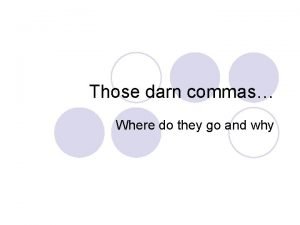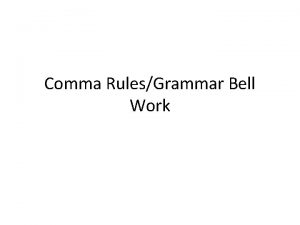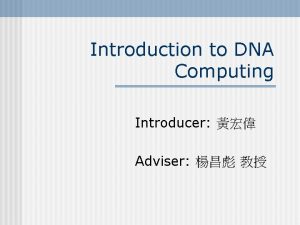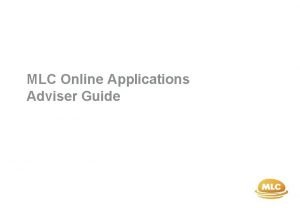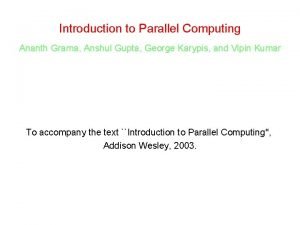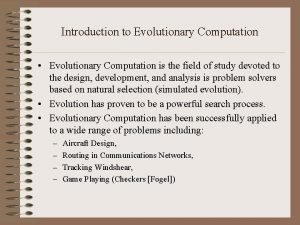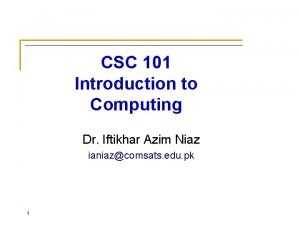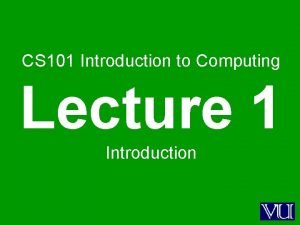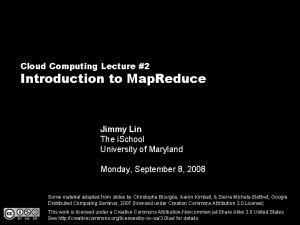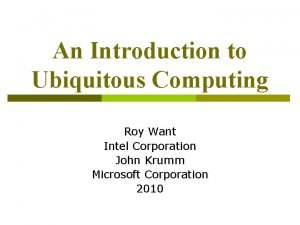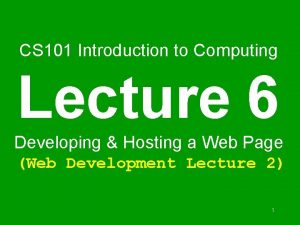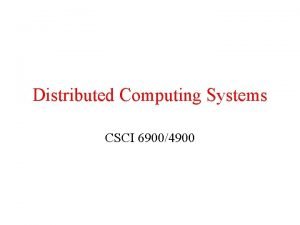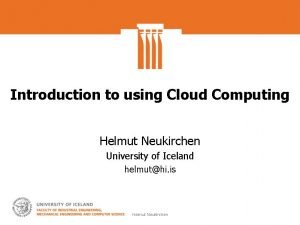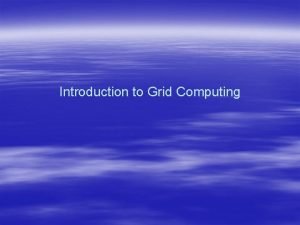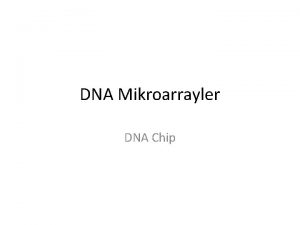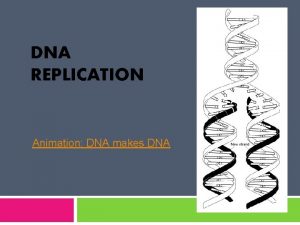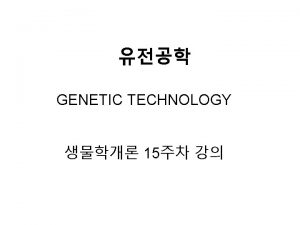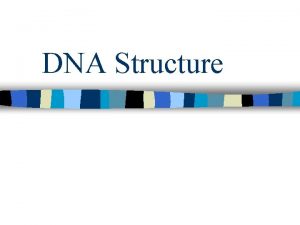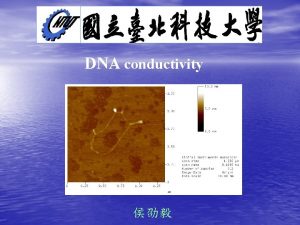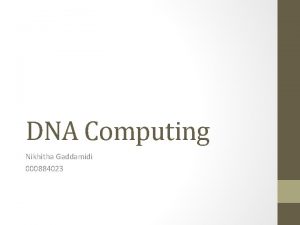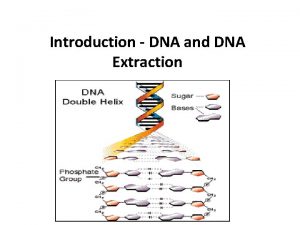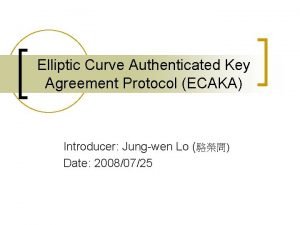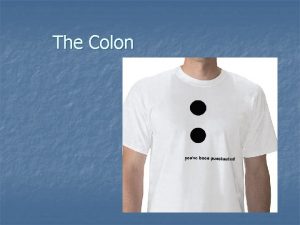Introduction to DNA Computing Introducer Adviser Definition A



























- Slides: 27

Introduction to DNA Computing Introducer: 黃宏偉 Adviser: 楊昌彪 教授

Definition A new computation paradigm n Employ molecule manipulation to solve computational problems n Data could be encoded in DNA strands, and molecular biology techniques could be used to execute computational operations n

Advantage n DNA computing has the potential to provide huge memories n Computing with DNA also has the potential to supply massive computational power

DNA Algorithm Concepts A DNA algorithm is applied a test tube consisting of DNA molecules which encode the input data A large set of data is assembled from the input data Those data are eliminated which do not correspond to solutions Gat some feasible answer

A Famous Example Molecular Computation of Solutions to Combinatorial Problems n Author: Leonard M. Adleman n Science, Vol. 266, pp. 1021 -1024, Nov. 1994 n

A Famous Example(cont. ) Hamiltonian Path Problem 4 3 1 0 6 2 5 Solution: 0 1 2 3 4 5 6

A Famous Example(cont. ) n HPP is a NP-Complete problem n No efficient (that is, polynomial time) algorithm exists for solving the problem

Algorithm for HPP 1. 2. 3. 4. 5. Generating random paths through the graph. Keep only those paths that begin with vin and end with vout. If the graph has n vertices, then keep only those paths that enter exactly n vertices. Keep only those paths that enter all of the vertices of the graph at least once. If any paths remain, say “Yes”; otherwise say “No”.

Implementing Step 1 n Each vertex encoded by random 20 bp sequences Vertex 2 TATCGGATCG GTATATCCGA Vertex 3 GCTATTCGAG CTTAAAGCTA GTATATCCGA GCTATTCGAG Edge 2>3

Implementing Step 2 & 3 Step 2: PCR by vertex 0 (starting point) and vertex 6 (ending point) n Step 3: Run on an agarose gel and Find the 140 -base bp band n PCR products encoding the desired path would have to be 7*20=140 bp n

Implementing Step 4 affinity-purification

Implementing Step 5 Find solutions by “graduated PCR”

Ant Colony Optimization Algorithm(ACO)

Ant Colony Optimization Algorithm(ACO)

Ant Colony Optimization Algorithm(ACO) 1. 2. 3. 4. 5. Set parameters and initialize pheromone trails Each of ants constructs a solution Calculate the scores of all solutions Update the pheromone trails If the best solution has not been changed after some predefined iterations, terminate the algorithm; otherwise, go to step. 2

Use ACO to Solve TSP n Problem: find a minimum length path in the input cities which every city is visited exactly once

Our Method Vi Vj Ei->j

Our Method n n 利用weight做為數量的控制, weight越小,量 越多 代表edge的DNA strand,中間設計了 restriction sites 把含有代表各種edge的strands置於tube 1, 將含有代表各個vertex的strand之 complementation置於tube 2 將兩個試管混合,則會有下列方法去造出initial data pool


Our Method 解決重複問題的方法 E 1 -2 E 2 -3 2` 2` E 3 -4 E 4 -2 E 2 -5

Our Method extend 2` 2` 剩下來完整的DNA strands 不會有重複的segment

Our Method 將經由上述兩個operation後剩下的DNA strands 加入另一個tube,其中的strand 形式如下: Ea-b Eb-c Ec-d Em-n 在另一個tube中 準備含有每一種edge的 complementation 的DNA segments C(Ei-j) 把兩個 tube的內容物混合

Our Method 此時在tube中的混合物,會作 hybrid 跟anneal 如下圖: Ea-b C(Eab) Eb-c Ec-d Em-n C(Ebc) C(Ecd) C(Ede)

Our Method Ea-b C(Eab) Eb-c Ec-d Em-n C(Ebc) C(Ecd) C(Ede) Restriction enzyme 會將double strand DNA 給切開 再利用切開的片段去進行複製



Thank you
 Introducer comma examples
Introducer comma examples Introducer comma examples
Introducer comma examples Trusted introducer
Trusted introducer Manuel roxas contribution in the philippines
Manuel roxas contribution in the philippines Ucas adviser
Ucas adviser Ceri evans
Ceri evans Mlc adviser guide
Mlc adviser guide Certified crop adviser certification
Certified crop adviser certification Office of the worker adviser
Office of the worker adviser Condo adviser
Condo adviser Function of dna polymerase 3
Function of dna polymerase 3 Bioflix activity dna replication dna replication diagram
Bioflix activity dna replication dna replication diagram Coding dna and non coding dna
Coding dna and non coding dna Enzyme involved in dna replication
Enzyme involved in dna replication Chapter 11 dna and genes
Chapter 11 dna and genes Conventional computing and intelligent computing
Conventional computing and intelligent computing Regarder introduction to cloud computing vidéos
Regarder introduction to cloud computing vidéos Introduction to parallel computing ananth grama
Introduction to parallel computing ananth grama Introduction to evolutionary computing
Introduction to evolutionary computing It 101 - introduction to computing
It 101 - introduction to computing Cs101 vu edu pk
Cs101 vu edu pk Introduction to mapreduce in cloud computing
Introduction to mapreduce in cloud computing Introduction to ubiquitous computing
Introduction to ubiquitous computing Mobility of bits and bytes
Mobility of bits and bytes It 101 introduction to computing
It 101 introduction to computing Introduction to distributed computing
Introduction to distributed computing Introduction to cloud computing
Introduction to cloud computing Introduction to grid computing
Introduction to grid computing
